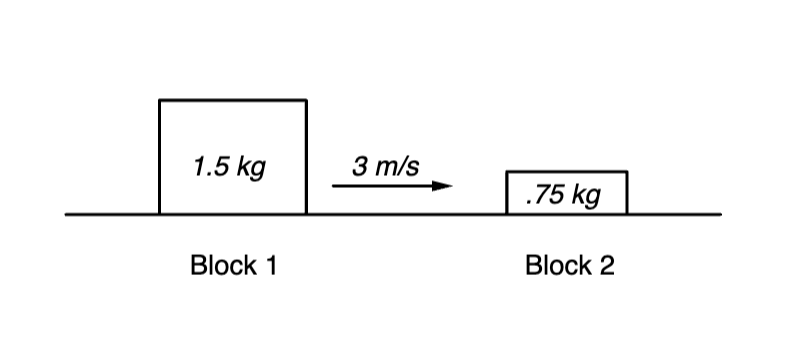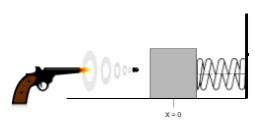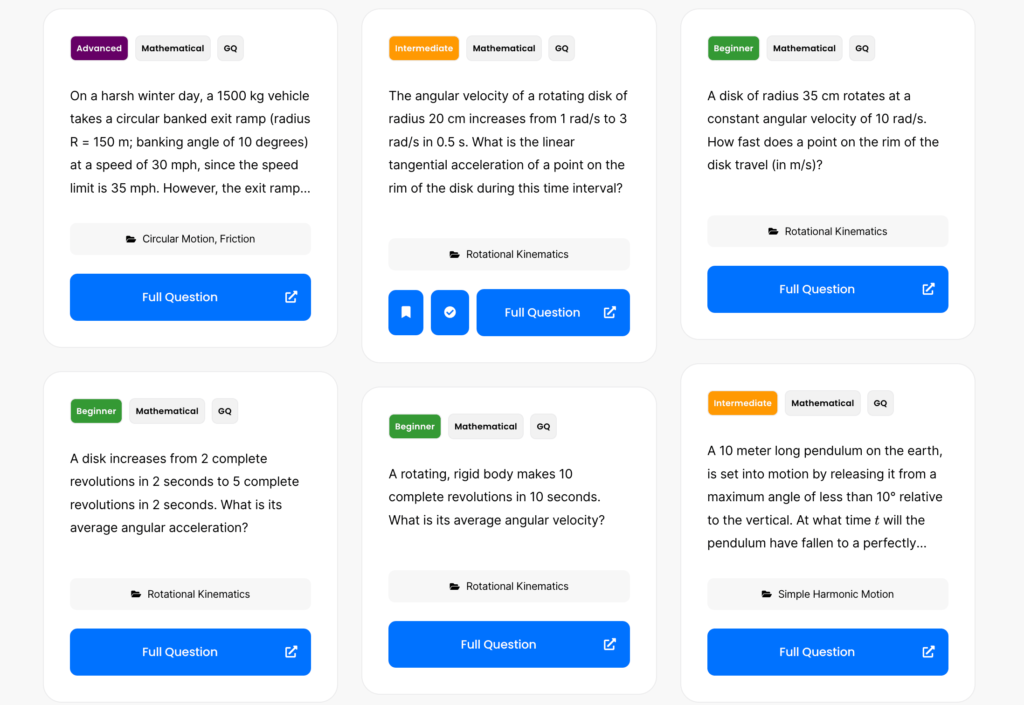0 attempts
0% avg
UBQ Credits
Part (a): Find the speed of the third piece
| Step | Derivation/Formula | Reasoning |
|---|---|---|
| 1 | Let [katex] m [/katex] be the mass of each smaller piece, thus the mass of the third piece is [katex] 2.5m [/katex]. | According to the problem, the third piece has 2.5 times the mass of each of the other two pieces. |
| 2 | [katex] \vec{p}_{\text{total}} = \vec{0} [/katex] | The total initial momentum is zero since the coconut was stationary before exploding. |
| 3 | Let [katex] \vec{v}_3 [/katex] be the velocity of the third piece and [katex] \theta [/katex] its angle from west towards south. Then, [katex] \vec{p}_{\text{total}} = m \vec{v}_S + m \vec{v}_W + 2.5m \vec{v}_3 = \vec{0} [/katex] [katex] \vec{v}_S = 18\, \text{m/s} \, \hat{j} \quad \text{and} \quad \vec{v}_W = -18\, \text{m/s} \, \hat{i} [/katex] [katex] -m \cdot 18 \, \hat{i} + m \cdot 18 \, \hat{j} + 2.5m \vec{v}_3 = \vec{0} [/katex] |
Set the total momentum as the vector sum of individual momenta. The pieces are moving south and west with the same speed but in perpendicular directions. |
| 4 | [katex] \vec{v}_3 = \left(\frac{18}{2.5}\right) \hat{i} – \left(\frac{18}{2.5}\right) \hat{j} [/katex] [katex] \vec{v}_3 = 7.2 \hat{i} – 7.2 \hat{j} \; \text{m/s} [/katex] |
Rearrange to find the velocity vector of the third piece. Cancel [katex]m[/katex] and solve for [katex] \vec{v}_3 [/katex]. |
| 5 | [katex] \text{Speed of third piece } |\vec{v}_3| = \sqrt{(7.2)^2 + (7.2)^2} = \sqrt{103.68} \approx 10.18 \; \text{m/s} [/katex] |
Calculate the magnitude to find the speed of the third piece. |
| 6 | 10.18 m/s | Answer for part (a), the speed of the third piece. |
Part (b): Find the direction of the third piece
| Step | Derivation/Formula | Reasoning |
|---|---|---|
| 1 | [katex] \tan(\theta) = \frac{-7.2}{7.2} = -1 [/katex] [katex] \theta = \tan^{-1}(-1) = 135^\circ \, \text{(from east counterclockwise)} [/katex] |
The angle [katex] \theta [/katex] is measured from the negative x-axis, thus the piece is moving to the northeast. Alternatively we can state that its 45 degrees north east. |
| 2 | 45 degrees north east | Answer for part (b). |
Part (c): Reducing the impact force of the collision for the bystander
| Step | Derivation/Formula | Reasoning |
|---|---|---|
| 1 | [katex] F = \frac{\Delta p}{\Delta t} [/katex] | Force experienced by the bystander can be reduced by increasing the impact time [katex]\Delta t[/katex] or reducing the momentum change [katex]\Delta p[/katex]. |
| 2 | Wear protective gear or position a net/barrier | By wearing protective gear or positioning an absorbent barrier (like a net), the bystander can prolong the impact time and reduce the force. |
| 3 | Use protective measures or barriers | Answer for part (c), suggesting that protective gear or an impact-absorbing barrier would reduce the effect of the collision. |
Just ask: "Help me solve this problem."
The two blocks of masses \( M \) and \( 2M \) travel at the same speed \( v \) but in opposite directions. They collide and stick together. How much mechanical energy is lost to other forms of energy during the collision?

Block 2 initially is at rest. Block 1 travels towards block 2 and collides with Block 2 as shown above. Find the final velocities of both blocks assuming the collision is elastic.

A bullet (mass: \(0.05 \, \text{kg}\)) is fired horizontally (\(v = 200 \, \text{m/s}\)) at a block (mass: \(1.3 \, \text{kg}\)) initially at rest on a frictionless surface. The block is attached to a spring (\(k = 2500 \, \text{N/m}\)). The bullet becomes embedded. Calculate:
A kickball is rolled by the pitcher at a speed of 10 m/s and it is kicked by another student. The kickball deforms a little during the kick, and then rebounds with a velocity of 15 m/s as its shape restores to a perfect sphere. Select all that must be true about the kickball and the kicking foot system.
A pool cue ball, mass 0.7 kg, is traveling at 2 m/s when it collides head on with another ball, mass 0.5 kg, traveling in the opposite direction with a speed of 1.2 m/s. After the collision, the cue ball travels in the opposite direction at 0.3 m/s. What is the velocity of the other ball?
By continuing you (1) agree to our Terms of Sale and Terms of Use and (2) consent to sharing your IP and browser information used by this site’s security protocols as outlined in our Privacy Policy.
| Kinematics | Forces |
|---|---|
| \(\Delta x = v_i t + \frac{1}{2} at^2\) | \(F = ma\) |
| \(v = v_i + at\) | \(F_g = \frac{G m_1 m_2}{r^2}\) |
| \(v^2 = v_i^2 + 2a \Delta x\) | \(f = \mu N\) |
| \(\Delta x = \frac{v_i + v}{2} t\) | \(F_s =-kx\) |
| \(v^2 = v_f^2 \,-\, 2a \Delta x\) |
| Circular Motion | Energy |
|---|---|
| \(F_c = \frac{mv^2}{r}\) | \(KE = \frac{1}{2} mv^2\) |
| \(a_c = \frac{v^2}{r}\) | \(PE = mgh\) |
| \(T = 2\pi \sqrt{\frac{r}{g}}\) | \(KE_i + PE_i = KE_f + PE_f\) |
| \(W = Fd \cos\theta\) |
| Momentum | Torque and Rotations |
|---|---|
| \(p = mv\) | \(\tau = r \cdot F \cdot \sin(\theta)\) |
| \(J = \Delta p\) | \(I = \sum mr^2\) |
| \(p_i = p_f\) | \(L = I \cdot \omega\) |
| Simple Harmonic Motion | Fluids |
|---|---|
| \(F = -kx\) | \(P = \frac{F}{A}\) |
| \(T = 2\pi \sqrt{\frac{l}{g}}\) | \(P_{\text{total}} = P_{\text{atm}} + \rho gh\) |
| \(T = 2\pi \sqrt{\frac{m}{k}}\) | \(Q = Av\) |
| \(x(t) = A \cos(\omega t + \phi)\) | \(F_b = \rho V g\) |
| \(a = -\omega^2 x\) | \(A_1v_1 = A_2v_2\) |
| Constant | Description |
|---|---|
| [katex]g[/katex] | Acceleration due to gravity, typically [katex]9.8 , \text{m/s}^2[/katex] on Earth’s surface |
| [katex]G[/katex] | Universal Gravitational Constant, [katex]6.674 \times 10^{-11} , \text{N} \cdot \text{m}^2/\text{kg}^2[/katex] |
| [katex]\mu_k[/katex] and [katex]\mu_s[/katex] | Coefficients of kinetic ([katex]\mu_k[/katex]) and static ([katex]\mu_s[/katex]) friction, dimensionless. Static friction ([katex]\mu_s[/katex]) is usually greater than kinetic friction ([katex]\mu_k[/katex]) as it resists the start of motion. |
| [katex]k[/katex] | Spring constant, in [katex]\text{N/m}[/katex] |
| [katex] M_E = 5.972 \times 10^{24} , \text{kg} [/katex] | Mass of the Earth |
| [katex] M_M = 7.348 \times 10^{22} , \text{kg} [/katex] | Mass of the Moon |
| [katex] M_M = 1.989 \times 10^{30} , \text{kg} [/katex] | Mass of the Sun |
| Variable | SI Unit |
|---|---|
| [katex]s[/katex] (Displacement) | [katex]\text{meters (m)}[/katex] |
| [katex]v[/katex] (Velocity) | [katex]\text{meters per second (m/s)}[/katex] |
| [katex]a[/katex] (Acceleration) | [katex]\text{meters per second squared (m/s}^2\text{)}[/katex] |
| [katex]t[/katex] (Time) | [katex]\text{seconds (s)}[/katex] |
| [katex]m[/katex] (Mass) | [katex]\text{kilograms (kg)}[/katex] |
| Variable | Derived SI Unit |
|---|---|
| [katex]F[/katex] (Force) | [katex]\text{newtons (N)}[/katex] |
| [katex]E[/katex], [katex]PE[/katex], [katex]KE[/katex] (Energy, Potential Energy, Kinetic Energy) | [katex]\text{joules (J)}[/katex] |
| [katex]P[/katex] (Power) | [katex]\text{watts (W)}[/katex] |
| [katex]p[/katex] (Momentum) | [katex]\text{kilogram meters per second (kgm/s)}[/katex] |
| [katex]\omega[/katex] (Angular Velocity) | [katex]\text{radians per second (rad/s)}[/katex] |
| [katex]\tau[/katex] (Torque) | [katex]\text{newton meters (Nm)}[/katex] |
| [katex]I[/katex] (Moment of Inertia) | [katex]\text{kilogram meter squared (kgm}^2\text{)}[/katex] |
| [katex]f[/katex] (Frequency) | [katex]\text{hertz (Hz)}[/katex] |
General Metric Conversion Chart
Example of using unit analysis: Convert 5 kilometers to millimeters.
Start with the given measurement: [katex]\text{5 km}[/katex]
Use the conversion factors for kilometers to meters and meters to millimeters: [katex]\text{5 km} \times \frac{10^3 \, \text{m}}{1 \, \text{km}} \times \frac{10^3 \, \text{mm}}{1 \, \text{m}}[/katex]
Perform the multiplication: [katex]\text{5 km} \times \frac{10^3 \, \text{m}}{1 \, \text{km}} \times \frac{10^3 \, \text{mm}}{1 \, \text{m}} = 5 \times 10^3 \times 10^3 \, \text{mm}[/katex]
Simplify to get the final answer: [katex]\boxed{5 \times 10^6 \, \text{mm}}[/katex]
Prefix | Symbol | Power of Ten | Equivalent |
|---|---|---|---|
Pico- | p | [katex]10^{-12}[/katex] | 0.000000000001 |
Nano- | n | [katex]10^{-9}[/katex] | 0.000000001 |
Micro- | µ | [katex]10^{-6}[/katex] | 0.000001 |
Milli- | m | [katex]10^{-3}[/katex] | 0.001 |
Centi- | c | [katex]10^{-2}[/katex] | 0.01 |
Deci- | d | [katex]10^{-1}[/katex] | 0.1 |
(Base unit) | – | [katex]10^{0}[/katex] | 1 |
Deca- or Deka- | da | [katex]10^{1}[/katex] | 10 |
Hecto- | h | [katex]10^{2}[/katex] | 100 |
Kilo- | k | [katex]10^{3}[/katex] | 1,000 |
Mega- | M | [katex]10^{6}[/katex] | 1,000,000 |
Giga- | G | [katex]10^{9}[/katex] | 1,000,000,000 |
Tera- | T | [katex]10^{12}[/katex] | 1,000,000,000,000 |
The most advanced version of Phy. 50% off, for early supporters. Prices increase soon.
per month
Billed Monthly. Cancel Anytime.
Trial –> Phy Pro
Try our free calculator to see what you need to get a 5 on the upcoming AP Physics 1 exam.
A quick explanation
Credits are used to grade your FRQs and GQs. Pro users get unlimited credits.
Submitting counts as 1 attempt.
Viewing answers or explanations count as a failed attempts.
Phy gives partial credit if needed
MCQs and GQs are are 1 point each. FRQs will state points for each part.
Phy customizes problem explanations based on what you struggle with. Just hit the explanation button to see.
Understand you mistakes quicker.

Phy automatically provides feedback so you can improve your responses.
10 Free Credits To Get You Started

By continuing you agree to nerd-notes.com Terms of Service, Privacy Policy, and our usage of user data.
NEW! PHY instantly solves any question
🔥 Elite Members get up to 30% off Physics Tutoring
🧠 Learning Physics this summer? Try our free course.
🎯 Need exam style practice questions? We’ve got over 2000.